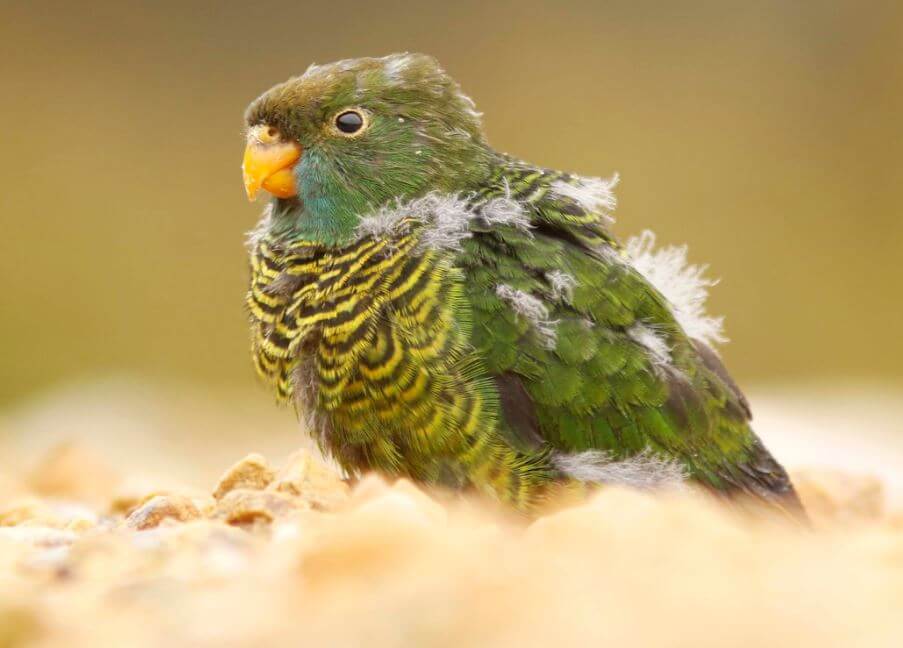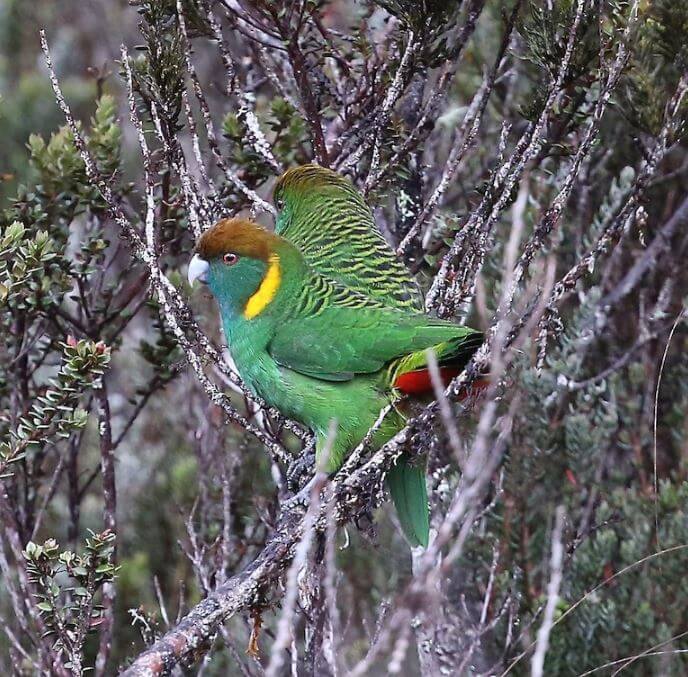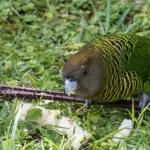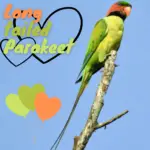
Painted Tiger Parrot (Eastern) 17–19 cm; 48–68 g. Bill silver-grey, with even paler tip; entire crown rufous-brown, face greyish brown, with yellow collar over the neck to sides of the throat;
throat and upper breast blue shading to green on belly; under tail-coverts red; mantle and back green barred black, shading to yellow barred black on rump; upper tail-coverts red; wings and tail green, duller below.
Female has dull greenish-blue face surrounded with rufous-brown of crown extending on neck-sides to replace yellow collar; breast and upper belly barred yellow and black, and also more densely barred upperparts.
Immature like a female, but head all brown. Race excels has an olive-brown crown. Brehm’s tiger parrot Psittaculidae 17–19 cm. Previously treated as conspecific with P. picta (see Taxonomy comments).
Crown dull brown, with blue-green cheeks and breast, and has yellow or green rump (not red as in P. picta), while ventral underparts are more yellow-green.
Brehm’s tiger parrot Female (which shares greenish face and has black and yellowish-green barring on rump and upper tail-coverts, like a male) and immature otherwise presumably differ from an adult male in the same respects as do corresponding sexes and ages of P. picta.
Editor’s Note: This article requires further editing work to merge existing content into the appropriate Subspecies sections. Please bear with us while this update takes place.
Painted Tiger Parrot (Snow Mountains)
Hitherto treated as conspecific with P. picta, but differs in its green vs brown chin, throat, and face (below cap); green vs red rump; reduced or non-existent blue on breast in male. Monotypic.
Painted Tiger Parrot (Eastern)
Hitherto was treated as conspecific with P. Lorenzi. Two subspecies were recognized.
Subspecies
Painted Tiger-Parrot (Snow Mountains)Psittacella picta lorentzi Scientific name definitions
P. p. lorentzi+1
Distribution
Painted Tiger-Parrot (Eastern)Psittacella picta picta/excelsa
P. p. picta+1
Psittacella picta excelsa Scientific name definitions
Distribution
Psittacella picta picta Scientific name definitions
Distribution
Distribution
Painted Tiger Parrot(Snow Mountains) WC New Guinea (Snow Mts).

Habitat
Painted Tiger Parrot (Snow Mountains): Subalpine shrubbery and low montane forest, including second-growth, preferably adjoining open grassland from which birds are sometimes flushed, from 2500 m to treeline (4000 m).
Painted Tiger Parrot (Eastern): Subalpine shrubbery and low substage within the montane forest, including second-growth, preferably adjoining open grassland from which birds are sometimes flushed, from 2500 m to treeline (4000 m), rarely descending as low as 1370 m.
Diet and Foraging
Painted Tiger Parrot (Snow Mountains): No specific data, though presumably similar to P. picta.
Painted Tiger Parrot (Eastern): Seeds and small hard berries, fruits of Dacrydium conifers. Feeds in small trees and shrubs, sometimes in company with P. madaraszi.
Sounds and Vocal Behavior

Painted Tiger-Parrot (Snow Mountains): Generally rather quiet. Vocalizations are reportedly most similar to those of P. brehmii (which is typically found at lower altitudes);
most typical is a musical and slightly nasal “err-ee” in contact, which has been likened to the call of one of the streaked honeyeaters (Ptiloprora).
Painted Tiger-Parrot (Eastern): Generally rather quiet. Vocalizations are reportedly similar to those of P. brehmii (which is typically found at lower altitudes); most typical is a musical and slightly nasal “nhrr-a-rehn”, while a harsh but subdued “chee-zeeddd” or “tschi-ziddd” has also been reported.
Breeding
Breeding-condition birds in Jun and Aug, with juvenile collected in Oct.

Conservation Status
(Snow Mountains): Not globally threatened. CITES II. A BirdLife “restricted-range” species. Widespread but generally scarce, though locally common. The world population of this species and P. picta combined has been estimated at 100,000 individuals.
(Eastern): Not globally threatened. CITES II. A BirdLife “restricted-range” species. Widespread but generally scarce, though locally common. A world population of this species and P. lorentzi combined has been estimated at 100,000 individuals.




















